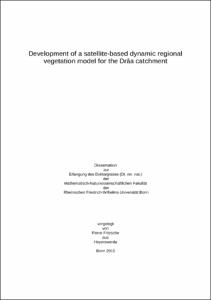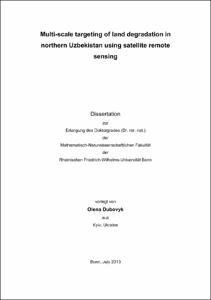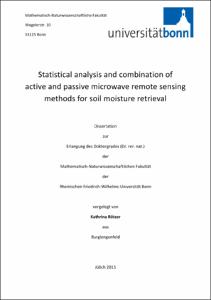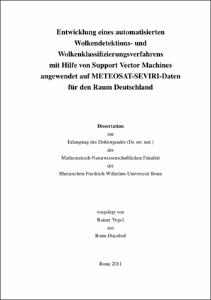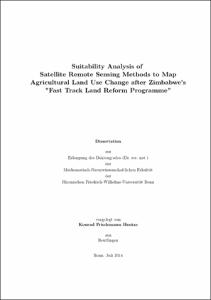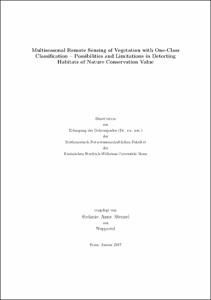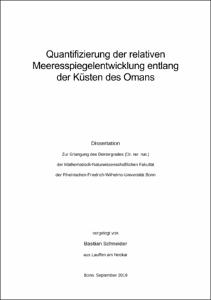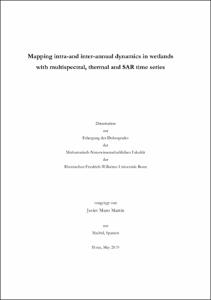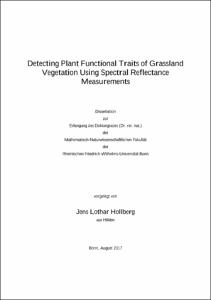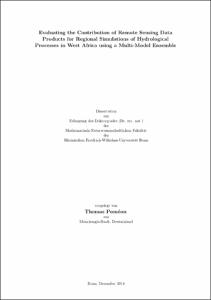E-Dissertationen: Search
Now showing items 1-10 of 10
Development of a satellite-based dynamic regional vegetation model for the Drâa catchment
(2011-02-07)
Analysing and modelling land cover dynamic of the vegetation under a changing hydrological cycle inside the semi-arid area resulting from the global climate change are a difficult task. It is important to be able to ...
Multi-scale targeting of land degradation in northern Uzbekistan using satellite remote sensing
(2013-11-13)
Advancing land degradation (LD) in the irrigated agro-ecosystems of Uzbekistan hinders sustainable development of this predominantly agricultural country. Until now, only sparse and out-of-date information on current land ...
Statistical analysis and combination of active and passive microwave remote sensing methods for soil moisture retrieval
(2016-08-15)
Knowledge about soil moisture and its spatio-temporal dynamics is essential for the improvement of climate and hydrological modeling, including drought and flood monitoring and forecasting, as well as weather forecasting ...
Entwicklung eines automatisierten Wolkendetektions- und Wolkenklassifizierungsverfahrens mit Hilfe von Support Vector Machines angewendet auf METEOSAT-SEVIRI-Daten für den Raum Deutschland
(2013-03-20)
Wolken stellen im Klimasystem der Erde einen zentralen Faktor dar, nicht nur in Bezug auf die Niederschlagsverteilung, sondern auch in Verbindung mit Effekten auf Strahlungsvorgänge innerhalb der Atmosphäre. Eine genaue ...
Suitability Analysis of Satellite Remote Sensing Methods to Map Agricultural Land Use Change after Zimbabwe's "Fast Track Land Reform Programme"
(2017-04-06)
Forced evictions of white commercial farmers in the year 2000 took the Zimbabwean land reform programme to a new level. While international media covered the tragedies of white farmers, the collapse of a state economy and ...
Multiseasonal Remote Sensing of Vegetation with One-Class Classification – Possibilities and Limitations in Detecting Habitats of Nature Conservation Value
(2017-07-03)
Mapping of habitats relevant for nature conservation often involves the identification of patches of target habitats in a complex mosaic of vegetation types extraneous for conservation planning. In field surveys, this is ...
Quantifizierung der relativen Meeresspiegelentwicklung entlang der Küsten des Omans
(2019-12-03)
Zentrales Thema dieser Promotion sind die Ursachen und Auswirkungen von Meeresspiegelschwankungen auf die Küste des Omans, welche auf verschiedenen Zeitskalen beleuchtet werden. Anhand der Küstenmorphologie, der Topographie ...
Mapping intra- and inter-annual dynamics in wetlands with multispectral, thermal and SAR time series
(2019-10-23)
Kartierung der intra- und interannuellen Dynamik von Feuchtgebieten mit multispektralen, thermischen und SAR-Zeitreihen
Die Analyse der aktuellen räumlichen Verbreitung und der zeitlichen Entwicklung ...
Die Analyse der aktuellen räumlichen Verbreitung und der zeitlichen Entwicklung ...
Detecting Plant Functional Traits of Grassland Vegetation Using Spectral Reflectance Measurements
(2018-03-06)
Changes in climate and an intensified agricultural use threaten grassland ecosystems in many places. To allow an efficient conservation of grassland vegetation communities, ecologists monitor variations in their plant ...
Evaluating the Contribution of Remote Sensing Data Products for Regional Simulations of Hydrological Processes in West Africa using a Multi-Model Ensemble
(2019-05-02)
Water is a crucial resource for human health, agricultural production and economic development. This holds especially true in West Africa, where large parts of the population work as self-sustaining farmers. Accurate ......


